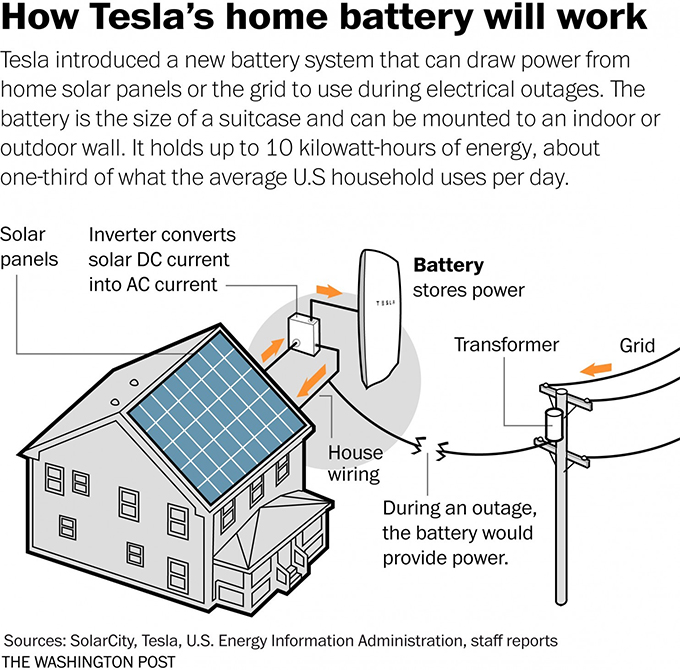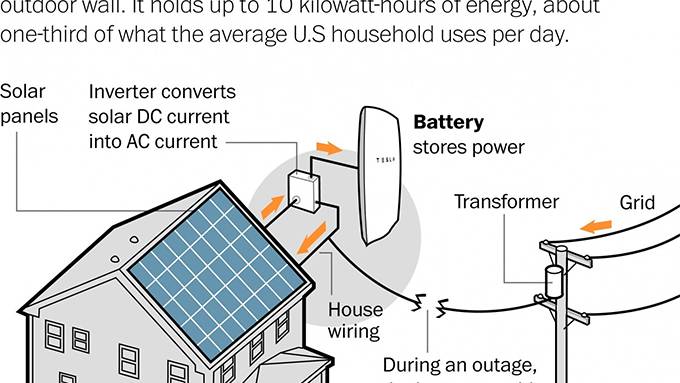What backing up your home with Tesla's battery might be like
Source: washingtonpost.com

Late Thursday, Tesla unveiled a suite of new battery products for homes, business, and even utility scale applications. The home product, dubbed the Tesla Powerwall, will store either 10 kilowatt-hours worth of energy (for $ 3,500) or 7 kilowatt-hours (for $3,000).
Importantly, though, these costs do not include the cost of installing the battery or the cost of a power inverter, meaning that what a customer actually pays could be substantially more. The company says it will start to deliver the batteries in “late summer.”
For those closely following developments in the energy storage space, there are two key details here that are worth considering — the cost of the battery itself, and what it would actually mean to have 10 kilowatt-hours of backup energy or energy storage in your home.
When it comes to price, these numbers are hardly cheap, but they’re also lower than some analysts were suggesting — figures like $13,000 were common in press coverage prior to Tesla’s announcement.
“The price points of the two Powerwall options for residential and small commercial segments will surely give minor jolts to the industry,” Ravi Manghani, an analyst with GTM Research, said in a statement. The prices are “slightly lower than what the world has come to expect of an expensive electric vehicle manufacturer. This announcement is expected to result in similarly aggressive price offers by other storage technology and system vendors.”
Tesla CEO Elon Musk presented his new Powerwall solar batteries on April 30, 2015. Musk says the batteries could dramatically reduce the use of fossil fuels by replacing use of the power grid. (AP)
The number is “well under the prices we and other research organizations have been looking at. Very exciting,” added Jesse Morris, a manager in the transportation and electricity programs of the Rocky Mountain Institute, a prominent energy think tank.
In addition to price, what homeowners will really care about is just how much backup power this product actually gets them — or how much it adds to the amount of solar-sourced energy that they can use to power their homes. Some simple numbers here can provide some context.
According to the U.S. Energy Information Administration, the average annual kilowatt-hour use for a U.S. utility customer (in the year 2013) is 10,908, or 909 kilowatt-hours per month. Divide that by 30 and per day, an average U.S. customer uses about 30 kilowatt-hours. So the battery could cover roughly a third of this.
However, that’s too simplistic an analysis, because really, a few key home appliances use up particularly large amounts of energy. For instance, running the laundry on “hot wash, warm rinse” takes up about 4.5 kilowatt-hours. Other devices, like your laptop computer or your TV, take up a lot less.
So what this means is that while 10 kilowatt-hours is probably not enough to power your whole home and all its utilities, as backup, when you’re not running the more energy hungry stuff, it would last for a while.
“If you were trying to go off grid with this, that would be a bit of a challenge,” says Peter Lilienthal, the CEO of Homer Energy, which co-authored a recent report with the Rocky Mountain Institute on the future of solar plus battery systems in homes. “It really isn’t designed for someone to cut the wire…But if you’re just concerned with outages — I’m not baking in my electric oven during the outage — 10 kilowatt hours is plenty for your lights, your electronics, and an efficient refrigerator.”
Granted, the people buying these $ 3,000 plus batteries aren’t likely to be average — they probably have larger homes, which use more energy.
And then there’s the matter of pairing up these batteries with solar panels. As Tesla notes, the key problem for home solar right now is that the most electricity use in the home generally occurs in the morning and especially in the evening — before work, after work. This just so happens to be precisely out of sync with when the sun itself is delivering the most accessible power (the middle of the day).
Thus, one idea behind pairing a home battery with solar panels is to store solar energy harnessed during the day and then deploy it in the evening, overnight, and the next morning. While the battery might not cover all energy uses during these times, it could reduce how much power needs to be purchased from a traditional utility and drawn from the grid.
But that’s not how the batteries will be used at first, says Peter Rive, co-founder of Solar City, which is offering the batteries for an additional cost when customers install solar panels. At first, Rive says, the battery will serve as a backup for when power goes out. But the ambitions are larger, and could eventually involve also helping customers use solar-sourced power in their homes even when the sun is no longer shining.
“We want to have batteries deployed with all of our solar power systems by the end of the decade,” says Rive.
There are still plenty of battery skeptics out there — particularly for utility scale applications, which Tesla is also pitching, announcing collaborations with Texas utility Oncor and Southern California Edison.
“The people I talk to, and this really is technical, suggest that it’s just going to be hard to make lithium ion cheap enough at grid scale to make widespread sense,” says Richard Schmalensee, a professor and former dean at the MIT Sloan School of Management who co-chaired MIT’s 2011 “Future of the Electric Grid” study. On the other hand, Oncor — a major distributor of power in Texas — has already suggested that it wants to invest several billion dollars on energy storage.
So there are a lot of details about the energy storage future that need to be worked out, especially as the market continues to grow. But for today, Tesla definitely seems to have gotten people pretty excited.
Source: washingtonpost.com






















